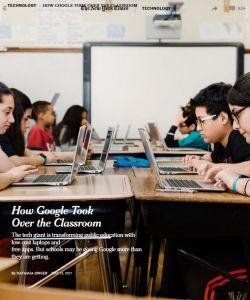Join getAbstract to access the summary!

Join getAbstract to access the summary!
Natasha Singer
How Google Took Over the Classroom
The tech giant is transforming public education with low-cost laptops and free apps. But schools may be giving Google more than they are getting.
The New York Times, 2017
What's inside?
Google’s strong presence in American classrooms may pave the way for a generation of loyal users.
Recommendation
Classrooms across the United States are rapidly becoming “Googlified.” About half of all American primary and secondary-school students today use Google Chromebooks at school. New York Times technology reporter Natasha Singer explains that a crucial ingredient of Chromebook’s success is the unconventional way Google markets the product and tailors its services to the needs of teachers. getAbstract recommends Singer’s in-depth look at how Google has conquered American classrooms and examines the implications for educators and marketing professionals.
Summary
About the Author
Natasha Singer is a technology reporter who covers digital learning and consumer privacy for The New York Times.
















Comment on this summary